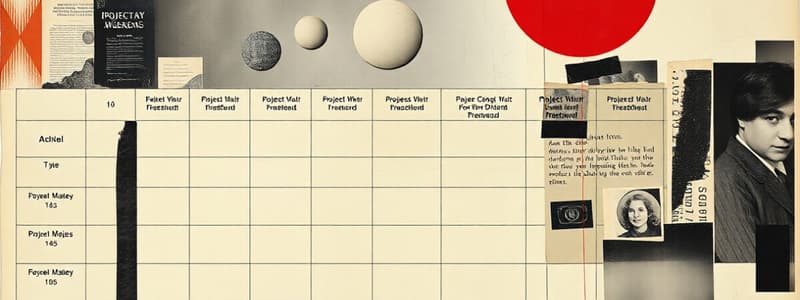Podcast
Questions and Answers
In the context of project planning, 'progressive elaboration' is described as a dynamic approach. What is the primary benefit of using progressive elaboration in developing a project management plan?
In the context of project planning, 'progressive elaboration' is described as a dynamic approach. What is the primary benefit of using progressive elaboration in developing a project management plan?
- It allows for flexibility and refinement of the plan as more detailed information becomes available and new insights emerge. (correct)
- It minimizes the need for initial stakeholder consultations, streamlining the planning process.
- It ensures the project plan is rigidly fixed from the outset, preventing scope creep.
- It accelerates the finalization of the project plan, reducing the overall planning phase duration.
During the 'Collect Requirements' process, a project manager decides to use 'benchmarking' as a tool. What does benchmarking primarily involve in this context?
During the 'Collect Requirements' process, a project manager decides to use 'benchmarking' as a tool. What does benchmarking primarily involve in this context?
- Analyzing past project documents to identify recurring requirements.
- Conducting brainstorming sessions with the project team to generate requirement ideas.
- Using questionnaires and surveys to systematically gather requirements from stakeholders.
- Comparing the project's requirements to industry best practices or standards from other organizations. (correct)
A project team is using 'voting' as a decision-making technique to prioritize project risks. If they want to ensure that the largest group's preference is chosen, even if it's not a majority, which voting method should they use?
A project team is using 'voting' as a decision-making technique to prioritize project risks. If they want to ensure that the largest group's preference is chosen, even if it's not a majority, which voting method should they use?
- Unanimity
- Majority
- Multicriteria Decision Analysis
- Plurality (correct)
In the 'Create WBS' process, decomposition is a key technique. What is the main purpose of decomposition in this context?
In the 'Create WBS' process, decomposition is a key technique. What is the main purpose of decomposition in this context?
During a project planning meeting, the team is using 'affinity diagrams'. What is the primary benefit of using affinity diagrams in the 'Collect Requirements' process?
During a project planning meeting, the team is using 'affinity diagrams'. What is the primary benefit of using affinity diagrams in the 'Collect Requirements' process?
Which of the following best describes the role of 'stakeholder input' in the Planning Process Group?
Which of the following best describes the role of 'stakeholder input' in the Planning Process Group?
A project manager is using 'context diagrams' in the 'Define Scope' process. What is the main purpose of using context diagrams?
A project manager is using 'context diagrams' in the 'Define Scope' process. What is the main purpose of using context diagrams?
In the 'Define Scope' process, 'product analysis' is mentioned as a tool and technique. What is the primary goal of product analysis in this context?
In the 'Define Scope' process, 'product analysis' is mentioned as a tool and technique. What is the primary goal of product analysis in this context?
Which input is crucial for both the 'Develop Project Management Plan' and 'Plan Scope Management' processes, as it provides the initial high-level information about the project?
Which input is crucial for both the 'Develop Project Management Plan' and 'Plan Scope Management' processes, as it provides the initial high-level information about the project?
During the 'Plan Schedule Management' process, 'alternatives analysis' is used as a tool and technique. How is alternatives analysis applied in this process?
During the 'Plan Schedule Management' process, 'alternatives analysis' is used as a tool and technique. How is alternatives analysis applied in this process?
Flashcards
Planning Process Group
Planning Process Group
Turning big ideas into actionable plans, defining project scope and mapping out key steps. Progressive elaboration keeps the plan flexible and refined.
Progressive Elaboration
Progressive Elaboration
A dynamic planning approach that keeps the plan flexible and refined as new insights emerge during the project.
Develop Project Management Plan
Develop Project Management Plan
Bringing every component of your project into one clear, integrated plan, defining, preparing and coordinating all the moving parts to outline the foundation.
Plan Scope Management
Plan Scope Management
Signup and view all the flashcards
Collect Requirements
Collect Requirements
Signup and view all the flashcards
Data Gathering
Data Gathering
Signup and view all the flashcards
Define Scope
Define Scope
Signup and view all the flashcards
Alternatives Analysis
Alternatives Analysis
Signup and view all the flashcards
Product Breakdown
Product Breakdown
Signup and view all the flashcards
Create WBS
Create WBS
Signup and view all the flashcards
Study Notes
Planning Process Group
- Big ideas take shape, and actionable plans are created within this group.
- Project scope is defined, objectives are sharpened, and steps are mapped out.
- It involves crafting the project management plan and key documents.
- Stakeholder input ensures alignment.
- The finalized plan becomes the baseline for tracking project performance.
- The project team should involve all appropriate stakeholders.
- Planning involves gathering project information, developing the Project Management Plan, and identifying project scope, cost, quality, communication, risk and procurement.
Planning Processes
- These are the 24Planning Processes
- Develop Project Management plan
- Plan Scope Management
- Collect Requirements
- Define Scope
- Create WBS
- Plan Schedule Management
- Define Activities
- Sequence Activities
- Estimate Activity Durations
- Develop Schedule
- Plan Cost Management
- Mitigate costs
- Determine Budget
- Plan Quality Management
- Plan Resource Management
- Mitigate Activity Resources
- Plan Communications Management
- Plan Risk Management
- Identify Risks
- Perform Qualitative Risk Analysis
- Perform Quantitative Risk Analysis
- Plan Risk Responses
- Plan Procurement Management
- Plan Stakeholder Engagement
Develop Project Management Plan
- The Develop Project Management Plan brings every project component into one integrated plan.
- You define, prepare, and coordinate the moving parts.
- The result is a comprehensive guide for all project work.
- It's a roadmap to ensure the team knows what to do and when.
Plan Scope Management
- This is about setting the stage for a successful project.
- It creates a clear plan so you can define, validate, and control the project and product scope.
- It ensures you have a roadmap to keep everything on track and avoid scope creep.
- The process is done once or at key milestones.
Collect Requirements
- Understanding, documenting, and managing stakeholder needs to achieve project goals are key to collecting requirements.
- Crucial because it lays the foundation for defining both the product and project scope.
- The process is carried out once or at key stages, ensuring everyone stays aligned.
Data Gathering
- This technique collects data and information from various sources.
- It is used to support project decision-making.
Data Gathering Tools and Techniques
- Brainstorming: Generates many ideas in a short period.
- Interviews: Involves one-on-one discussions with stakeholders.
- Focus Groups: Uses structured discussions with a diverse group.
- Questionnaires & Surveys: It systematically gathers data from stakeholders through questionnaires or interviews.
- Benchmarking: Compares practices, processes, or metrics with other organizations.
Data Analysis
- Document Analysis: Existing documents are reviewed to uncover valuable insights and information.
- Diving into relevant information to uncover valuable insights is involved.
- Reviewing and assessing key documents that can shape decisions and strategies is key.
- Examples of documents: agreements, business plans, repositories, process flows, marketing materials, plans, logs, procedures, reports, requests, and use cases.
- Document analysis ensures essential tool for informed decision-making.
Decision Making
- Voting: A collective approach to decision-making to assess alternatives.
- Unanimity: Everyone agrees on a single course of action.
- Majority: Over 50% of the group supports a decision, use an odd number to avoid ties.
- Plurality: The largest block in the group decides, even without a majority, useful when more than two options exist.
- Autocratic Decision-Making: One person takes charge for efficiency.
- Multicriteria Decision Analysis: A decision matrix evaluates options based on risk, uncertainty, and value.
Data Representation
- Data representation presents information clearly for smart project decisions.
- Affinity Diagrams: Groups and organizes ideas for better review and to pinpoint causes of defects.
- Mind Maps: Explores concepts, connections, and relationships visually.
Interpersonal and Team Skills: Nominal Group Technique
- The Nominal group technique combines creativity with structure, helping teams effectively prioritize the best ideas.
- A question/problem is presented, and each person brainstorms independently.
- A moderator collects ideas on a visible board or flip chart.
- The team discusses each idea for understanding.
- Participants privately vote to rank ideas (1-5). Multiple rounds narrow down to the best ideas.
Observation and Conversation
- Allows you to understand how people work by watching their environment and processes.
- Known as “job shadowing,” it uncovers hidden requirements and needs.
Facilitation
- Facilitation turns group discussion into a valuable event
- Skilled facilitator ensures:
- Everyone participates effectively.
- The group reaches a shared understanding.
- Every idea and contribution is valued.
- Decisions are supported by all participants.
- Agreed actions are followed up appropriately.
Context Diagrams
- This diagram is a visualizing product scope tool
- The business system and connects people is what it illustrates
- It models highlights inputs, actors, and outputs.
Prototypes
- This is a way to gather early feedback by showcasing a working model. -Small-scale product -Computer model -Mock-up -Simulation
- Storyboarding is another prototyping tool that brings ideas to life through images or illustrations.
- Storyboards are used across industries to visually map out a journey.
Define Scope
- This is about creating a clear, detailed description of the project.
- This sets boundaries and defines acceptance criteria.
- Process often occurs at project milestones.
Alternatives Analysis
- This is about evaluating options to tackle project work and finding the most effective approach within constraints.
Product Analysis
- Used to shape products and services.
- Asking the right questions and uncovering answers to define how a product will be are important aspects to this.
- Product Breakdown: This is deconstructing a product into smaller parts.
- Requirements Analysis: Pinpointing exactly what the product needs to succeed.
- Systems Analysis & Engineering: Exploring how components interact.
- Value Analysis & Engineering: Maximizing functionality while minimizing cost.
Create WBS
- Creating a Work Breakdown Structure (WBS) breaks down project deliverables and tasks into manageable pieces.
- Happens once or at specific milestones during the project.
Decomposition
- This breaks down a project’s scope and deliverables into manageable pieces.
- Work package is the smallest unit within the WBS.
- Project into work packages steps: -Identifying and analyzing deliverables -Structuring the WBS -Breaking down higher-level components -Assigning identification codes to WBS components -Ensuring the correct level of detail
Plan Schedule Management
- This is about setting up the policies, procedures, and tools to plan, create, manage, and control your project schedule.
- Happens once or at key moments during the project’s lifecycle to ensure things stay aligned.
Studying That Suits You
Use AI to generate personalized quizzes and flashcards to suit your learning preferences.




